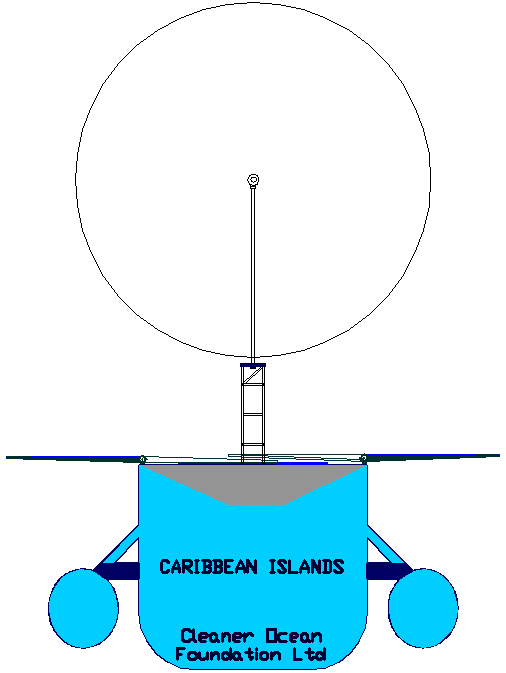|
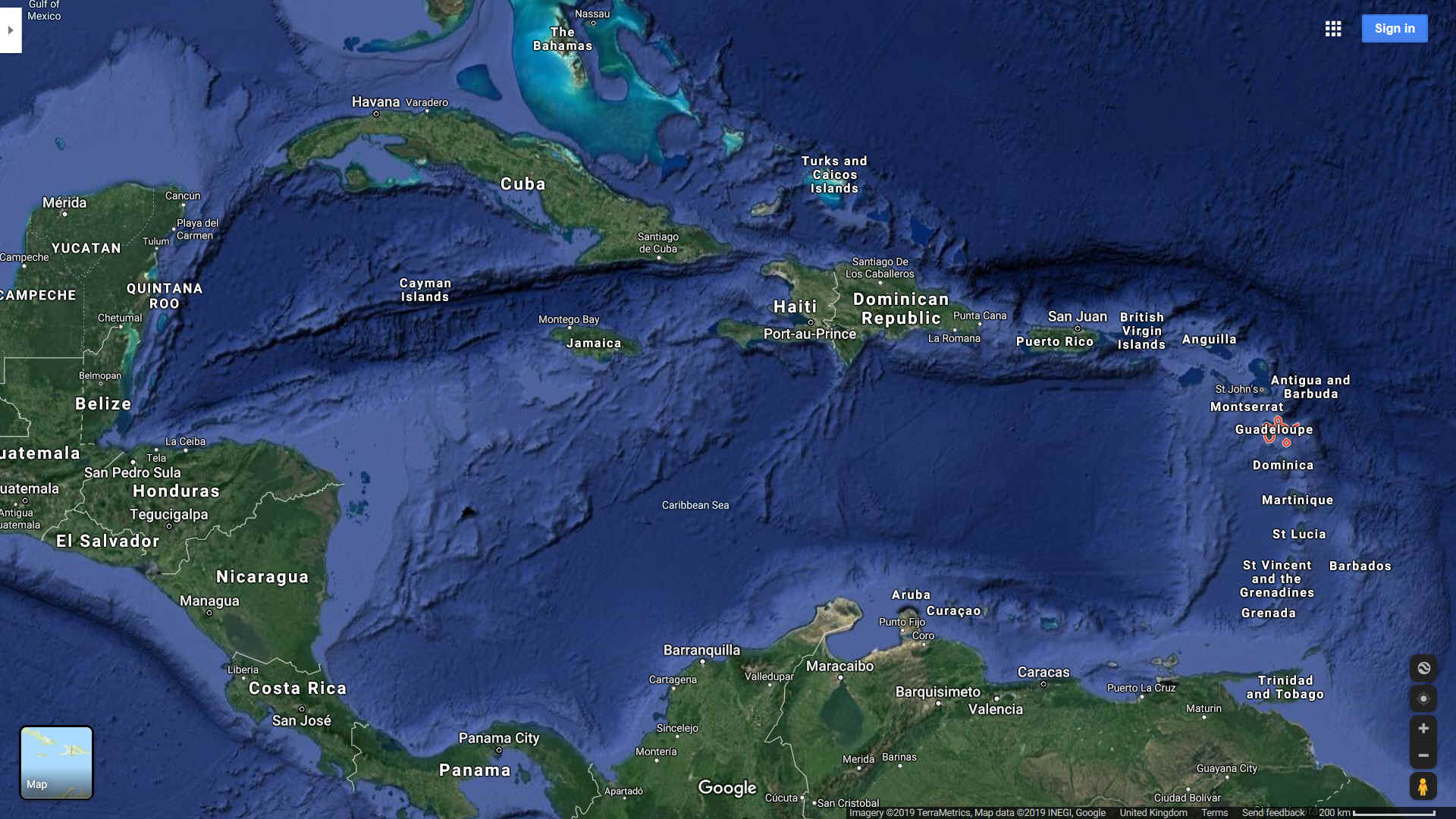
The
Caribbean Islands are serviced by many diesel powered ferries operating
between Trinidad & Tobago, St, Lucia, Puerto Rico, Dominican Republic,
Jamaica, Cuba and the Cayman Islands, typically supplied by and to
neighboring mainland's. The situation is as described in this series of
proposals for the Mediterranean and Pacific Islands. Indeed, there are many
other locations around the world that will benefit from low cost, zero carbon
ferries, much like the Scottish Isles in the UK.
There is presently no ferry service between Barbados and the other Caribbean islands. There was a ferry service between Barbados and Guadeloupe, with stops in St. Lucia, Dominica and Martinique.
Bahamas Ferries has car and passenger services from the capital Nassau to destinations on Eleuthera, Exumas, Andros and
Abacos.
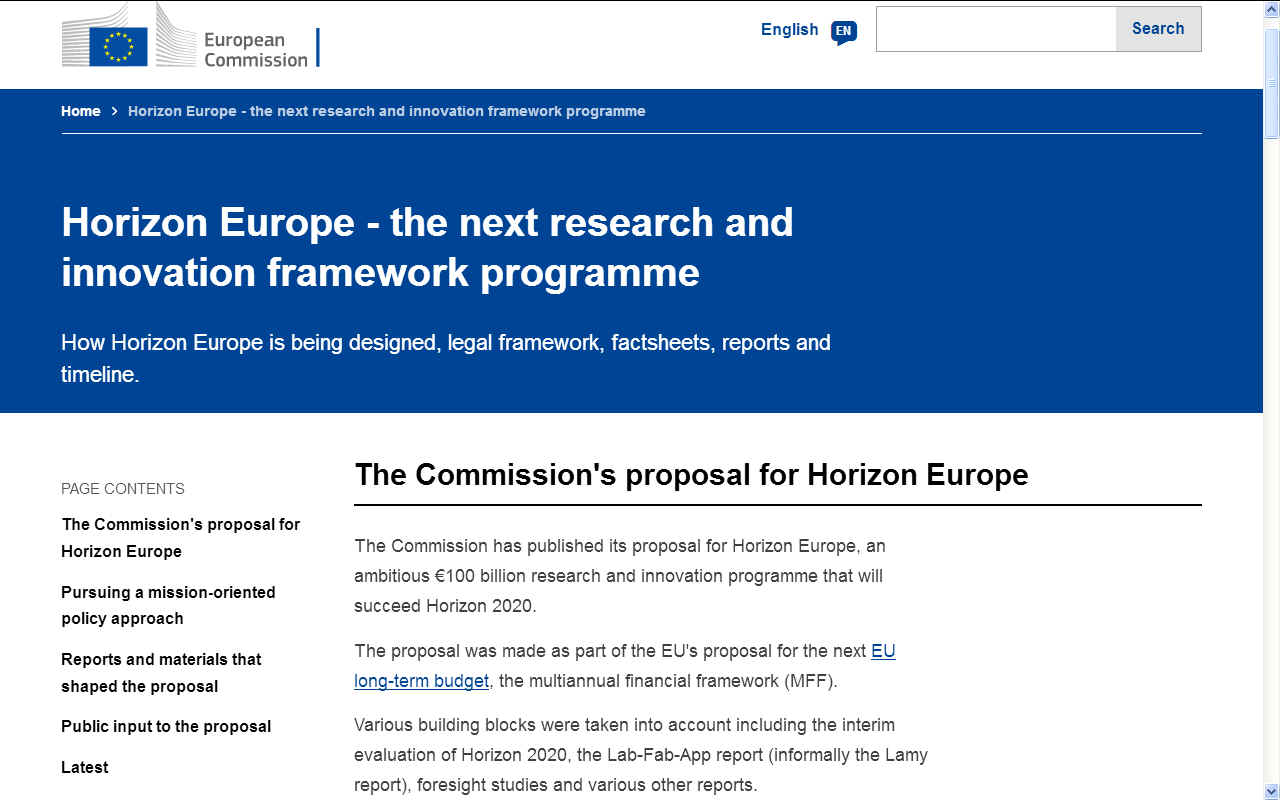
WHAT
IS THIS H2020 COLLABORATIVE RESEARCH PROPOSAL ?
We
propose conducting research to define as far as it is possible from studies and a first stage analysis of data, to discover if
zero emissions transport on water might be
possible using wind and solar energy harvesting directly by cargo and
passenger ships to include RoRo ferries, with
onboard harvesting apparatus, rather than impose significant
and costly infrastructure challenges to harbours with limited resources and
lower passenger numbers, that the introduction of hydrogen
fuel cell or other propelled vessels might not be economical.
This
blue growth
inspired Proposal is to include the following work packages in combination
and as a comprehensive package, though presently in draft form:
1.
Investigative research and development relating to horizontal versus vertical
axis wind turbines against rotary sails, to obtain the maximum thrust from a
given area and mass for silent operation, based on a computer controlled
system, and safe docking in ports and harbours.
2.
The application of solar panel tracking and wing deployment in relation to
hull stability and rotary sails in harsh weather conditions, to include
docking in ports to obviate infrastructure complications.
3.
Superstructure optimization in relation to the proposed hullform and
solar/wind energy harvesting.
4.
Hullform design in relation to the proposed solar and wind energy harvesting
system, to include tank testing of a suitable scale model for stability.
5.
Course optimization study in relation to wind and solar energy harvesting in
the Pacific region, to include the development of autopilot compatible
data sets to enhance effective course keeping.
6.
Non-dependent autonomous monitoring of course keeping (5.) to ensure adherence to optimized
course keeping and data streaming for analysis of energy harvesting
application to enhance vessel performance.
7.
Effective satellite communications to support vessel optimization and data
dissemination in 5. and 6. above.
8.
Feasibility study to reveal a workable method and practical timeframe for
the transition
from fossil fuel powered to
zero carbon vessels, aimed at saving costs and disruption for operators during
changeover.
9.
A study of selected ports and routes for ability to support the proposed technology shift
from fossil fuels to zero carbon shipping, to include
(where applicable) comparison of hydrogen
infrastructure in terms of practical cost implementations in relation to 1.
- 5. above.
10.
At the conclusion of 1. - 9. incorporation of the developed research of the
proposed dual energy harvesting system onto a medium size prototype cargo (container)
vessel to confirm
or disprove the theoretical study results. The prototype vessel is also to be used
to promote the technology by way of demonstrations at events and in relation
to requests by interested third parties, especially concerning media articles
and news reports - in this case to show that cargo in standard
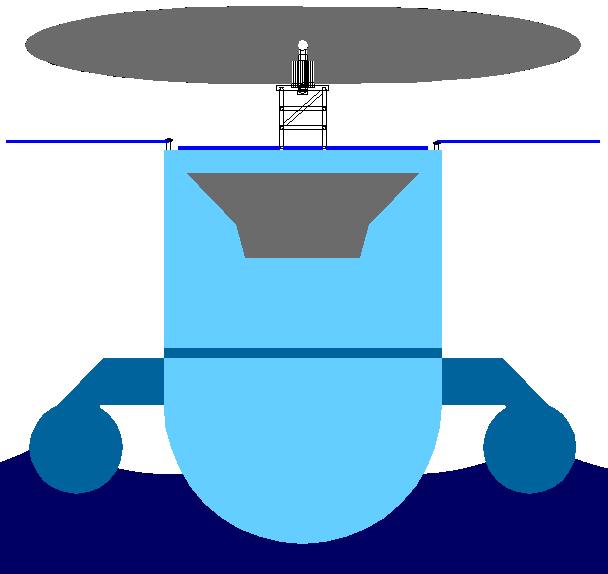

SUSTAINABLE
CONTAINER SHIPS - This is the same container transport shown with the
turbines furled, as if docked in port. When folded down like this the blades
do not revolve and may be locked. By this means ports do not have to alter
their support for zero carbon ships.
The
concept may be doubled and quadrupled without too much trouble. You'd need to
up-scale by a factor of 8 to match the 400 meter giants that operate today to
carry 960 standard containers. See our top ten list below. That is nowhere
near the capacity of a heavy bunker fueled behemoth, but it is a formula for
zero carbon transportation that is theoretically workable and should be tried
and developed to compare operating costs. We believe that such a system could
replace bunker fuels and eliminate the need for liquid fuels that may be
potentially dangerous.
Meantime,
LNG
offers some respite and a system based on these components, that is less
integrated, might be tacked onto existing ships to assist propulsion and lower
fuel consumption - as an interim measure during the transition to sustainable
shipping.
GAS
GUZZLERS See our list of the top
ten fossil fueled giants that we eventually hope to replace by this
research. You may notice from the specification of these behemoths that we
are in the right ballpark for power to cargo ratio when comparing DWT to
installed engine power:
|
RANKED
|
SHIP
NAME
|
No. BUILT |
LOA
|
TEU
|
KW/TON/DWT |
|
-
|
-
|
- |
-
|
-
|
- |
|
1.
|
MSC
GULSUN
|
5 |
399.9
|
23,756
|
0.379 (0.50hp) |
|
2.
|
OOCL
HONG KONG
|
5 |
399.9
|
21,413
|
0.316 (0.42hp) |
|
3.
|
COSCO
Shipping Universe
|
3 |
400.0
|
21,237
|
N/A |
|
4.
|
CMA
CGM Antoine de Saint Exupery
|
2 |
400.0
|
20,954
|
0.368
(0.49hp) |
|
5.
|
Madrid
MAERSK
|
10 |
399.0
|
20,568
|
0.3
(0.4hp) |
|
6.
|
Ever
Golden
|
10 |
400.0
|
20,388
|
N/A |
|
7.
|
MOL
Truth
|
1 |
399.0
|
20,182
|
N/A |
|
8.
|
MOL
Triumph
|
3 |
400.0
|
20,170
|
0.427
(0.57hp) |
|
9.
|
COSCO
Shipping Taurus
|
4 |
399.8
|
20,119
|
N/A |
|
10.
|
Barzan
|
5 |
400.0
|
19,870
|
N/A |
|
-
|
-
|
- |
-
|
-
|
- |
|
00
(Proto)
|
BMS
ZECV 1
|
- |
50.0
|
6
|
0.37
(0.49hp) |
WHO
WILL COORDINATE THE PROJECT ?
Bluebird
Marine Systems Ltd is coordinating this bid with the
help of the Cleaner
Ocean Foundation Ltd in a supporting role to help build a
consortium. They are
assembling a European consortium of academics and businesses to
look at the the feasibility of using a wind and solar energy
system in a more developed way to provide zero carbon
transport for the Pacific Ocean islands to and from mainland
suppliers and destinations.
The coordination team includes:
Nelson Kay:
Project coordination
Briggette Dusart: Project administration
Chris Close: Project management
Richard
Whelan: Logistics
Danny Goldsmith: Design steerage (Naval architect)
Lloyd Stebbings: Build steerage
The
project is to define and subsequently to demonstrate a formula for
sustainable blue water ocean transports, the
aim being to interest commercial ship
builders to undertake further development as a result of these
researches. Such as whether the concept
may be scaled up from the at present medium size example, to
cargo and cruise
ships. The research being to contrast the power to weight ratio and
storage capacity of such an energy harvesting system balanced against
cargo carrying ability, navigation and other refinements,
to define a formula for delivering sustainable transport for
the Pacific region.
THE
CONSORTIUM
The
consortium consists of the following (up to 20*)
organizations in no particular order :
-
European Universities
-
European software developers
-
A British wind turbine developer
-
A European naval architect
-
A British University**
-
European Port authorities
-
A European boat builder
-
A European eco boat developer
-
A European coatings producer
-
A European ferry operator
-
A European Electronics company
-
A European electric motor manufacturer
WHEN
WILL THE PROJECT COMMENCE ?
An
application must be filed with the European Commission early January 2020.
We
are aiming
for a start on this project for 2020/21, the actual start date being dependent on
agreement with the European Commission as to scope, level of funding,
together with initial payments being made to all consortium partners.
RO-RO
FERRY END
ELEVATION - In these drawing we see a 50 meter RoRo ferry
that is designed to service tourism and deliver supplies between the
Caribbean Islands. The rotary sails
provide a significant area, but may be increased to improve performance. The turbines can be raised
and lowered to cope with different running conditions and furled for docking
in ports or during storm conditions. The main hull is not the ideal, but a
compromise shallow draft design - to accommodate two Ford Transit vans side
by side (12 in total). The passenger areas are below decks. The outriggers provide
stability against roll induced by the wind turbines. Please note that these drawings
are Design Copyright © December 6 2019, and
the hull configuration and energy harvesting system are patent
protected.
WHY
DO THEY WANT TO DO THIS ?
With
the present climate emergency likely to worsen without some immediate action,
vessels that are zero carbon should be put to good use wherever possible.
At the present time there appears to be no system for marine craft that would allow for the intelligent dual harvesting of solar and wind energy in such autonomous combination, so as to be able to provide sufficient energy for propulsion at speeds of up to 10
knots for sustainable
transportation to support tourism as part of circular economic development and 15-20 knots for
island hopping.
INTERNATIONAL
MARITIME ORGANIZATION
Where the International Maritime Organization are aiming for a 40% reduction in greenhouse gas emissions for 2030, we should like to develop an automated solar and wind energy harvesting system for boats, that may be up-scaled for ships, to provide power to weight ratios between
2.00kW continuous and 3.6kW peak, per ton of vessel (specs dependent) Such targets require computer automated solar and
rotary sail tracking to minimize shading, lightweight structures and integrated
hydraulics,
coupled with advanced navigation.

ANGULAR
MOVEMENT - The
picture shows the angle of rotation of the moveable wind turbines on a
collapsible (space frame) mast that is raised and lowered using hydraulic rams.
The wind turbines work with the solar panels using computers and sensors to maximize
the collection of energy from nature. During this project, rotary sails will
replace ordinary wind turbines. Design copyright © 21-09-19 Cleaner
Ocean Foundation Ltd,
all rights reserved.
INNOVATIVE
ASPECTS OF THE PROJECT ?
Solar and wind energy systems have been used on vessels for well over a decade, but so far no harvesting system has combined the two energy sources into one compatible system at such a scale
and with robotic automation so as to become the primary propulsive
force.
The
technology is patent
protected, with a further improvement patent in the pipeline to cover IPCT
stakeholders. The objective of
securing such IP rights is to be able to share them with European and
International collaborative partners and advance the state of knowledge for mankind in the
publication.


ANGULAR
MOVEMENT - These
pictures show the angle of rotation of the moveable solar arrays and how the solar arrays fold over each other when
stowed, seen in end elevation. Design
copyright © 27-04-19 Cleaner Ocean Foundation Ltd, all rights reserved.
Experimentation, including the incorporation of new ideas in combination is needed to push forward the boundaries of human knowledge.
Hydrogen fuel cell systems have been proposed involving dockside storage of a difficult to handle gas in liquid form, where solar and wind energy properly harvested could provide a viable alternative, meaning that long range cruising using energy directly from nature, could once again become the preferred method of transporting goods from one country to another. Any conversion, such as splitting water, and compressing and cooling a gas to form a liquid, is less efficient, even where solar and wind farms may provide the base energy free from nature.
The present proposal seeks to define a formula by which the inefficiencies of the
hydrogen fuel cell cycle may be
avoided in the interests of using energy from nature efficiently.
History
shows us that many solutions to important problems of the day were provided
by unconventional people, such as John
Harrison, inventor
of the marine
chronometer, but that those solutions were rejected by the Board of
Longitude - despite the urgency. Let us hope this might not happen again in
a climate
emergency where we need solutions quickly to make up for lost time.
WHAT IS THE POTENTIAL
ENVIRONMENTAL IMPACT ?
This research, if it is successfully implemented in a developed form, could
offer one potential solution to the search for long range zero carbon ships of the
future, and so provide a means to secure sustainable transport for the
economies of the Pacific geographical region.
This research and development, if it is successfully demonstrated as described, offers one potential solution to the search for long range
zero carbon ships of the
future.
The United
Nations SDGs
and IMO
targets for zero carbon shipping is 40% of the fleet by 2040
in an effort to stave off global warming.

ENERGY
SECURITY - This is a draft design for a small ferry for channel crossings
and operation in along Caribbean coasts. Such
development could free us from the oil based economy currently fueling global
warming. Design Copyright © September 2019, Cleaner Ocean Foundation Ltd.
The hull configuration and energy harvesting system are patent
protected.
HOW
MUCH WILL THE PROJECT BUDGET BE ?
We are a not for profit research company, enabling us to complete development
at a fraction of the cost of commercial operations with shareholders and
dividends. BMS
does not pay dividends to shareholders and COF
has no shares.
The 'Leads' will coordinate the consortium in relation to agreed work
packages as follows :
- .
-
.
-
.
-
.
-
.
-
.
-
.
-
.
Subtotal
-
Contingency (25%)
Total
PROJECT PLAN:
estimated 156 week duration in month size bites
This research project will proceed as follows:
WEEKS
1 - 16:
|
1-
4: |
5-8: |
9-12: |
13-16: |
|
- |
- |
- |
- |
- |
- |
- |
|
.. |
.. |
.. |
.. |
|
.. |
.. |
.. |
.. |
1
- 16: ....
WEEKS
17 - 32:
|
17-20 |
21-24* |
25-28 |
29-32 |
|
- |
- |
- |
- |
- |
- |
- |
|
.. |
.. |
.. |
.. |
|
.. |
.. |
.. |
.. |
17
-32: Interim progress report ...
WEEKS
33 - 48:
|
33-36 |
37-40 |
41-44 |
45-48 |
|
- |
- |
- |
- |
- |
- |
- |
|
. |
. |
. |
. |
|
. |
. |
. |
. |
33
- 48: ....
WEEKS
49 - 64:
|
49-52 |
53-56 |
57-60 |
61-64 |
|
- |
- |
- |
- |
- |
- |
- |
|
. |
. |
. |
. |
|
. |
. |
. |
. |
49
- 64: Half way interim reports
WEEKS
65 - 80
|
65-68 |
69-72 |
73-75 |
77-80 |
|
- |
- |
- |
- |
- |
- |
- |
|
.. |
.. |
.. |
.. |
|
.. |
.. |
.. |
.. |
65
- 80: ......
WEEKS
81 - 96
|
81-84 |
85-88 |
89-92 |
93-96 |
|
- |
- |
- |
- |
- |
- |
- |
|
.. |
.. |
.. |
.. |
|
.. |
.. |
.. |
.. |
81
- 96:
WEEKS
97 - 104
|
97-100 |
101-104 |
- |
- |
|
- |
- |
- |
- |
- |
- |
- |
|
.. |
.. |
.. |
.. |
|
.. |
.. |
.. |
.. |
97
- 104: Final reports, accounting and presentations ......
WEEKS
105 - 156
...
The following are some
islands where travelers often reach their final destination by relying on the ferry system.
CARIBBEAN
ISLANDS - FERRY DEPENDENT DESTINATIONS
| Main
Island or Nation |
Ferry
Dependent Destinations |
| Antigua
and Barbuda |
Barbuda |
| Belize |
San
Pedro |
| Grenada |
Carriacou
Petite Martinique |
| Puerto
Rico |
Culebra
Vieques |
| Trinidad
and Tobago |
Tobago |
| Turks
and Caicos |
North
Caicos
Middle Caicos
South Caicos |
| Yucatan
Peninsula |
Cozumel
Holbox
Isla Mujeres |
The
Caribbean sea is the only thing connecting each of the subject countries to the other, and boats are the way many people cross between them. Ferries often offer island-hopping tours that take travelers to see several different locales.
Ferries are used by the local population to get from island to island where distances are close enough to make this a cost effective and practical form of transportation.
It is possible to plan your entire vacation around the ferries in some areas. In these locations you can spend a few days on one island, then take the ferry to another island, where you'll enjoy a new and different experience. Best of all, the journey between islands will allow you to enjoy the sunshine, salt air and open water views, at a lower cost than if you fly between the islands.
Some of the best opportunities for island hopping are in the Bahamas and in the United States and British Virgin Islands, where ferries are one of the most popular forms of public transportation, and you'll enjoy beautiful views as you make your way between the islands.
Another interesting opportunity is offered by the island of Anguilla, and the two-nation island of Saint Martin and Sint
Marteen, where you can take an international voyage in a matter of minutes. Although they are right next to each other, these nations each have their own ambiance and culture, allowing you to experience British, French and Dutch-imbued cultures on a single vacation.
Another option, but much farther south, is to visit two or all three of the ABC Islands in the Dutch Antilles. This discussion of island hopping wouldn't be complete without a brief mention of Bermuda where the local ferry system works in conjunction with the bus system to provide public transportation across this tiny island chain. Although it's not actually in the Caribbean, Bermuda is a very special place, and the ferries add to its charm.
The beauty of traveling via ferries lies in the fact that you have the opportunity to experience the beauty and diverse culture of multiple islands at a much lower cost than if you were to fly or sail by private charter boat.
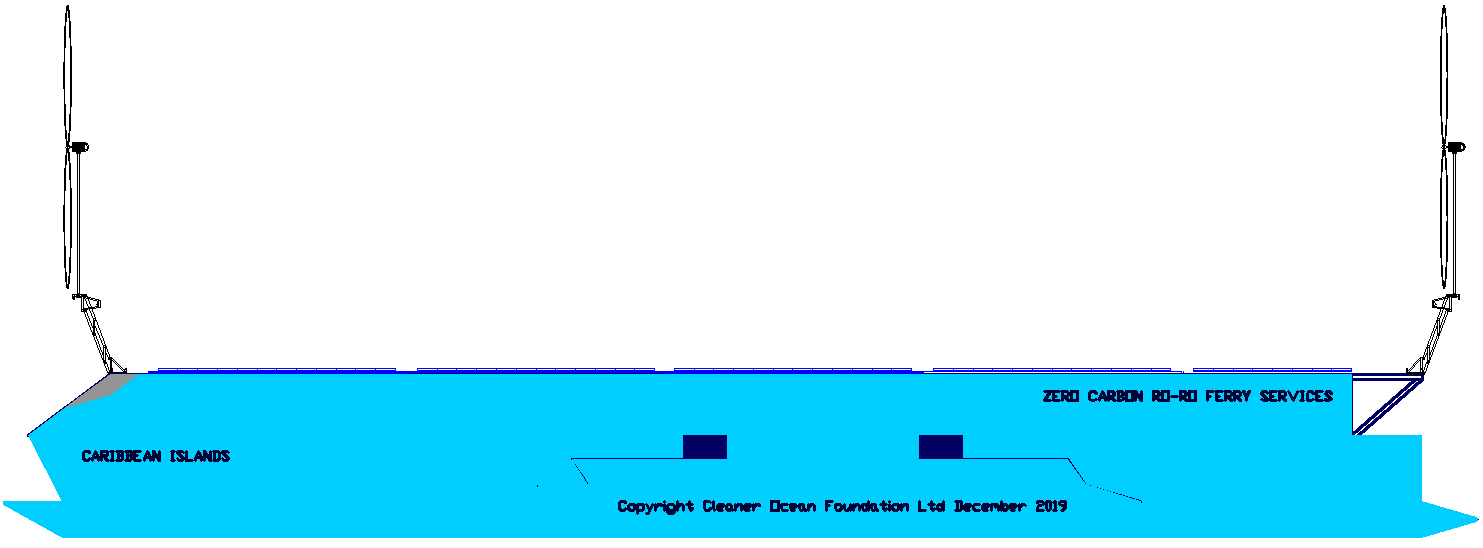
ZERO
CARBON RORO - This is a small roll-on roll-off ferry designed to carry 12
large vans, with passenger rooms below decks. She is a zero carbon design
featuring twin wind generators that also add to thrust directly from the wind
(like sails) and a full deck of solar panels that track the sun - including a
battery store. The age of zero carbon shipping is dawning, with designs like
this leading the way. Design Copyright © December 6 2019.
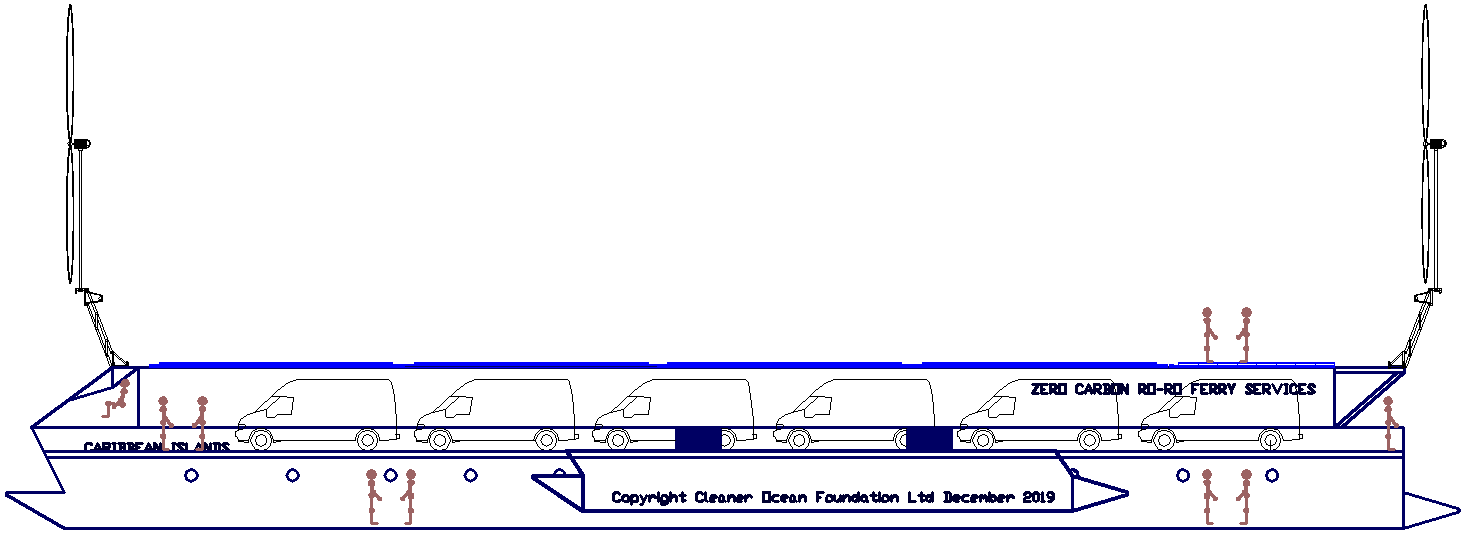
In
2018, the Seychelles launched the world’s very first sovereign blue bond. That issuance was for a total of $15 million worth of 10-year bonds for the purpose of protecting marine environments and safeguarding
fisheries. In
September 2019 the Pacific
Blue Shipping Partnership announced their intention to raise $400
million by issuing a blue bond. The coalition includes the governments of Fiji, the Marshall Islands, Samoa, Vanuatu, the Solomon Islands and
Tuvalu. They have set an emissions reduction target of 40% by 2030, and full decarbonisation by 2050.
Dr. Peter Nuttall, a scientific and technical adviser for the Micronesian Center for
Sustainable Transport at the University of the South
Pacific, says shipping is a “lifeline” for every Pacific nation:
“Without shipping, our economies die, our people can’t survive. In places like the Solomon Islands or the Marshall Islands, 80% to 90% of all goods arrive by ship. We have the most expensive shipping in the world, the longest transport routes, and the worst ships.”
Dr.
Nuttall added that nations in the Pacific “cannot wait for the rest of the world. We have to bespoke design a Pacific solution if it is going to work, not leave the Pacific to languish."
We
offer that the same situation applies to the Caribbean.
There are not abundant ferry connections between the islands of the Caribbean. As a result lots of travellers use airplanes to hop from one island to another. Several airlines offer the opportunity to buy air passes which can be a good deal. In the Pacific distances between the islands are bigger there are options for travellers to move between islands and fly home from a different island other the one on which they arrived. Aside from ferries, you can also use other boats, including (private) yachts, cruise ships or even cargo ships.
If you have the time and luck, you might be able to find a yacht to go with or maybe some cargo transport. Those options are not listed, but for some countries this actually is the only option, so shopping around for a place could be interesting. Countries without international connections include Cuba, Haiti, the Cayman Islands, Barbados, the ABC Islands Aruba, Curaçao and Bonaire (although they used to have connections with each other in the past) and Saint Kitts and Nevis, among other smaller islands. Most other countries and islands have several international and/or domestic services. Although technically not considered part of the Caribbean in this travel guide, a few ferries in Mexico and Venezuela are mentioned, as well as a reference to Central America for more information about Caribbean islands off the coast of for example Honduras, Belize and Panama.

NORTH and WEST CARIBBEAN
Florida - Bahamas
Balearia Caribbean has ferry services between Fort Lauderdale and Grand Bahama or Bimini.
Bahamas
1. Bahamas Ferries has car and passenger services from the capital Nassau to destinations on Eleuthera, Exumas, Andros and Abacos. Fast daily ferry services travel between Nassau and most of the main islands. The main connections are:
- Nassau to Abacos - about 4 hours between Sandy Point, Great Abaco and Nassau
-
Nassau to Eleuthera - two-hour run from Potter’s Cay in Nassau to Harbour Island. It also runs a ferry from Potter’s Cay to Governor’s Harbour.
-
Nassau to Exumas - Departs the Bahamas Ferriesdock at Potter’s Cay for the overnight journey to the Exumas. The scheduled 12-hour trip can stretch closer to 14 depending on the weather.
-
Nassau to Andros - There’s a two-hour ferry run by Bahamas Ferries from Nassau to Fresh Creek on Andros.
Other services with Bahamas Ferries include Cat Island - Nassau, Driggs Hill - Nassau, Current - Nassau, Fresh Creek - Morgans Bluff, George Town - Nassau and Spanish Wells - Nassau. The latter leaves Nassau at 8:00am and arrives in Spanish Wells around 10:00am, and is often advertised as a possible daytrip as well.
2. Pinder’s Ferry operates small boat running twice a day between McLean’s Town, Grand Bahama and Crown Haven on Little Abaco.
3. On the Abacos, the Albury's Ferry Service operates regular ferries between Marsh Harbour and Great Guana and Scotland Cay, Man-O-War Cay and Hope Town. Also on the Abacos, there is the Green Turtle Ferry
Service between Treasure Cay Airport and Green Turtle Cay.
To add, there are water taxis between Nassau and Paradise Island regularly making the crossings. Several other offshore islands and their neighboring cays are served by private water taxis. Also, there are about 20 mail boats serving many islands, including the Outer Islands further away to the south and southeast. Although less comfortable, they are a great but slow alternative to the normal ferries and water taxis.
Jamaica
Because of the fact that Jamaica is not really close to most other Caribbean islands, international services are non-existent. But there are several options of taking a ferry between a few coastal towns/cities in the country. One option is to board a ferry from the capital Kingston to Port Royal. There is also a ferry between Port Antonio and Navy Island, only just over 5 minutes away from the mainland.
Haiti
There are several domestic ferries travelling between the mainland of Haiti and several islands off the coast. Services include those to and from the capital Port-au-Prince and Jérémie and between Cote des Arcadins and Ile de la Gonave.
Cayman Islands
There is a ferry between North Sound and Rum Point on Grand Cayman which takes about 40 minutes each way. The ferry departs from the Hyatt Regency Canal at 10:00am, noon and 4:00pm on Mondays - Thursdays, on Friday to Sunday the last one leaves at 6pm. The return times from Rum Point are 11:00am, 3:00pm and and 6:30pm Mondays - Thursdays, on Friday to Sunday the last one is at 9:15pm.
Turks and Caicos Islands
There are several options regarding domestic ferry services in the Turks and Caicos Islands. The Dale Marie is a weekend ferry between Bottle Creek in North Caicos and Middle Caicos. It runs Saturdays from about 8:00am through early afternoon. It is a 30-minute ride and carries 1-2 vehicles. Friday evenings and Sundays crossings are by appointment only.
The Buccaneer is a ferry between Grand Turk and Salt Cay. It is passenger only and it takes about 30 to 45 minutes. Travelling is one Wednesdays and Fridays only and it departs Salt Cay at 7:00am and Grand Turk at 2:30pm.
TCI Ferry Service is a ferry service between Walkin Marina Leeward on Providenciales and Sandy Point Marina on North Caicos. with 4 departures each day in both directions. There are 5 daily departures in both directions from Monday to Saturday and 3 on Sundays and holidays. It's US$25 for a single trip and US$40 for a same day return ticket. Check current timetables online.
Dominican Republic
There are several domestic services to take in the Dominican Republic. One of those is between Samana and Sabana de la Mar. Another option is to take one of several ferries in the southeastern part of the country, for example to Saona Island. More islands and national parks can be explored by ferry here.
Dominican Republic - Puerto Rico vv
Ferries del Caribe offers three weekly ferries between Santo Domingo, the capital of the Dominican Republic and Mayagüez in Puerto Rico. From Santo Domingo they leave on Sundays, Tuesdays and Thursdays at 8:00pm arriving in Mayagüez at 8:00am the following morning. From Mayagüez, Puerto Rico, they leave on Mondays, Wednesdays and Fridays at 8:00pm, and arrive in Santo Domingo at 8:00am the next morning. The journey takes about 12 hours in both directions.
Puerto Rico
There are ferries between the main island of Puerto Rico and some island to the east. Boats leave Fajardo for the islands of Culebra and Vieques at least four times a day to either island. It takes around one hour and services are with the Puerto Rican Port Authority Office.
Puerto Rico - United States Virgin Islands vv
Every two weeks leaving on a Sunday at 1:00pm, there is a fast ferry between Fajardo in Puerto Rico and St. John and St. Thomas in the United States Virgin Islands. In the opposite direction, boats leave every two weeks on a Thursday at 5:00pm from St. John and 6:00pm from St. Thomas. The trip takes about 2 hours and services are with Transportation Services Virgin Islands.
United States Virgin Islands
There are about 4 operators which have ferry services between St. Thomas (Charlotte Amalie and Red Hook) and Tortola (West End and Road Town). Contact Road Town Fast Ferry for options. From Road Town on the British Virgin Islands there are ferries about every 3 hours, that take 50 minutes to Charlotte Amalie on the island of Saint Thomas in the
United States Virgin Islands. From Red Hook to Road Town is about 35 minutes. Contact Caribbean Maritime Tortola Fast Ferry (340) 777-2800), Smith's Ferry (340) 775-7292 or Native Son Inc. (340) 774-8685 for details about schedules and prices.
Speedys operates ferries between Virgin Gorda and St Thomas, sometimes via Tortola.
There are about 4 or 5 sailings in each direction between Cruz Bay, St. John (USVI) and West End, Tortola (BVI).
There are also two ferry operators offering a service between St. Thomas (Red Hook and Charlotte Amalie) and Virgin Gorda.
There are 2 crossings a day on Fridays, Saturdays and Sundays between Red Hook, St.Thomas and Cruz Bay, St. John (USVI) for Jost Van Dyke (BVI).
Contact Inter Island Boat Service (340) 776-6597 for these last three international connections by ferry.
British Virgin Islands
There are at least 6 operators between several destinations within the British Virgin Islands with many connections on a daily basis. Two of them have services between Tortola and Virgin Gorda. Other connections include Virgin Gorda to Beef Island vv, Tortola to Jost van Dyke vv, Beef Island to Marine Cay vv and Tortola to Peter Island vv. Check the schedule (also between BVI and the US Virgin Islands) at the BVI Welcome site. Smith's Ferry now also makes sailings to and from the northern island of Anegada from both Tortola (Road Town) and Virgin Gorda
(Spanish Town) three times a week in both directions.
Other operators between several islands include North Sound Express and Speedy's. New Horizon Ferry travels between West End on Tortola and Jost's Great Harbour on Jost van Dyke.
Mexico
There are two companies offering ferries between Playa del Carmen and the island of Cozumel of the coast of Yucatan. Crossings are about 15 times a day, with very early (starting at 5:00am) and late (up to midnight) sailings being a possibility to do some long daytrips. There are also ferries from the mainland to Isla Mujeres.
Central America
In Central America, there are several possibilities of travelling between the mainland and the islands of the coast in the Caribbean sea. Although not mentioned in dept here, you have the possibility for example of travelling to the Bocas del Toro of the coast of
Panama and to Roatan island of the coast of Honduras. Many other options are available, but check the Central America guide and the individual countries for details.
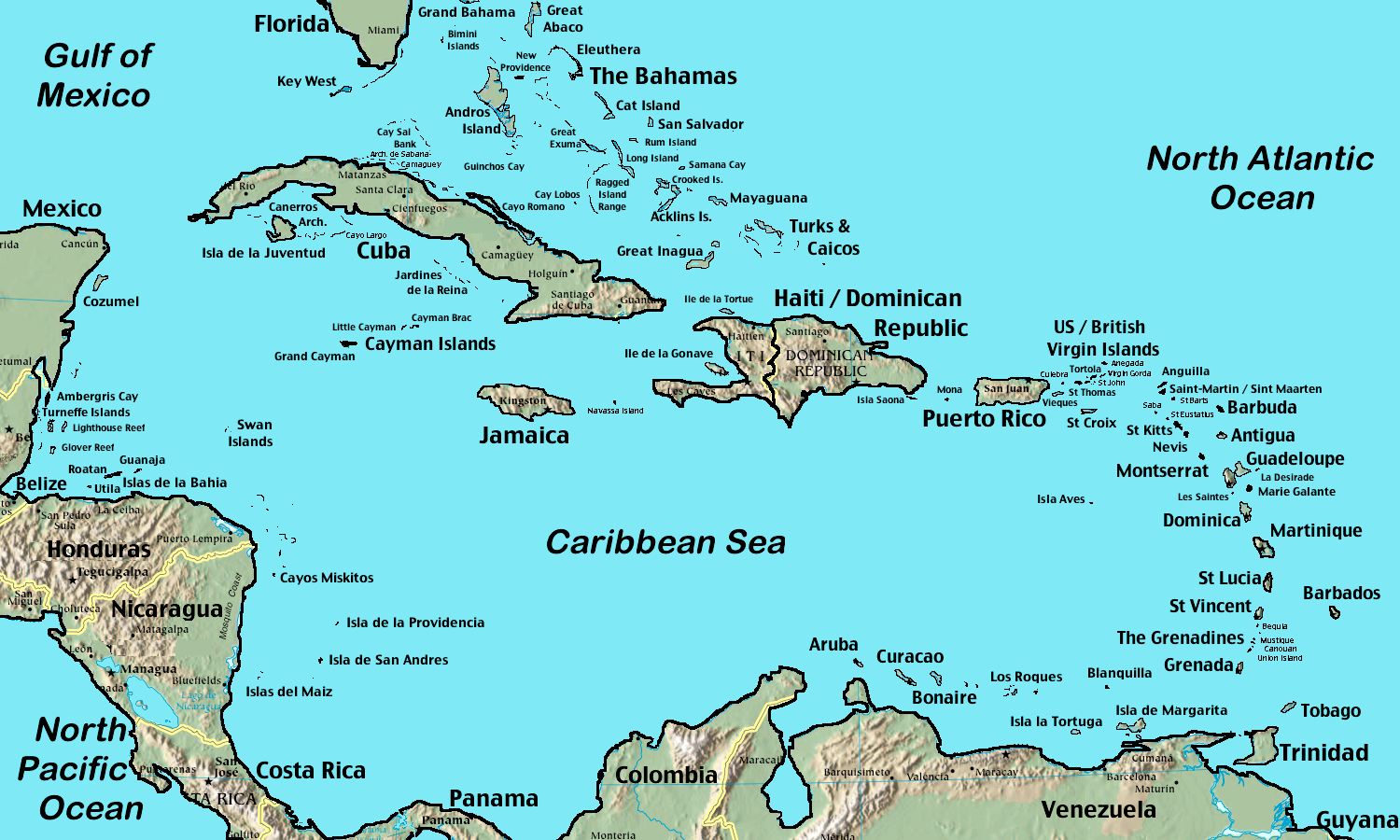
SOUTH and EAST CARIBBEAN
Anguilla - Saint Martin vv
In season, ferries operated by the Anguilla Ferry System run between the islands of Anguilla and Saint Martin. They leave daily between 7:00am and 7:00pm roughly every 20 minutes between Blowing Point (Anguilla) and Marigot on the French part of St. Maarten/St. Martin.
Anguilla - Sint Maarten vv
Although it takes a little longer compared to Saint Martin, there is also a convenient route between Anguilla and Sint Maarten directly. Ferries travel between Blowing Point in Anguilla and Philipsburg in Sint Maarten. For more information about prices and schedules of this trip can be obtained by calling (264) 497 6665.
Saint Martin - Saint Barthélemy vv
There are possibilities to go by ferry from Saint Martin to Saint Barthélemy. The MV Voyager travels two times daily between Marigot to Gustavia, except on Wednesdays and Sundays, when it leaves from Oyster Pond on Sint Maarten (Dutch part of the island). It takes about 75 minutes from Marigot, 45 minutes from Oyster Pond. The ferries leave at 9:00am and 6:45pm.
Sint Maarten - Saint Barthélemy vv
The MV Voyager travels daily and on Wednesdays and Sundays twice daily (one in the morning at 9:00am and one in the early evening at 6:45pm) between Oyster Pond and Gustavia.
Another option is to take the high speed ferry The Edge that travels to Gustavia once a day from Tuesday till Saturday. It leaves from Pelican Marina in Dutch St. Maarten at 9:00am. This passage lasts around 45 minutes.
Sint Maarten - Saba vv
The MV Dawn II has sailings 3 times a week according to schedule between Philipsburg on Sint Maarten and Fort Bay on Saba, both leeward islands of the Netherlands Antilles. Crossings are on Tuesdays, Thursdays and Saturdays, leaving Saba in the morning and returning from Sint Maarten in the late afternoon, taking about 2 hours each way. Sometimes there are cancellations, so check the latest schedule over here.
Another option is taking the Edge Ferry, departing Pelican Marina in St. Maarten at 9:00am on Wednesday, Thursday, Friday, Saturday and Sunday, returning from Saba later that day. It takes about 90 minutes to cover the sea between the islands.
Saint Kitts and Nevis
In Saint Kitts and Nevis six ferries operate between the islands of Saint Kitts and Nevis: the MV Caribe Queen, MV Carib Breeze and MV Carib Surf, the MV Mark Twain, the MV Geronimo and the MV Sea Hustler. The MV Mark Twain is currently inactive, but the other 5 vessels have a total of 15 sailings a day between both islands in either direction, between 6:30am (first sailing from Saint Kitts) to 7:00pm (last sailing from Saint Kitts). From Nevis, the first one leaves at 7:00am and the last at 6:00pm. Crossings take about 45 minutes and provide an excellent way of travelling between the capital Basseterre on Saint Kitts and Charlestown, the 'capital' of Nevis.
Antigua and Barbuda
The Antigua to Barbuda Ferry takes 1.5 hour and the ferry departs at 8:30am on Wednesdays, Thursdays, Saturdays and Sundays from Saint John's, arriving at River Dock, Barbuda. The return service from Barbuda departs at 3:15pm on the same days. On Tuesdays and Fridays the service departs Antigua at 4:45pm and returns the following day from Barbuda at 6:30pm. Reservations can be made by phone (001 268 464 9453). Or check the Antigua Ferries website.
Antigua - Montserrat vv
The MV Fjortof is operated by Twin Islands Ferry Service Ltd (TIFS) and commenced regular ferry services to Montserrat from Antigua in December 2009, with a one-way trip time of approximately 90 minutes. The fares for the ferry service are EC$125.00 for a one-way-trip, EC$250.00 for an adult return trip and children under 12 pay EC$120 (US$1 = EC$2.65). Each passenger is allowed 2 pieces of baggage free of charge and any additional baggage is charged at EC $50.00 per piece.
No advance ticketing is required, as travelers can purchase their tickets upon check-in. To facilitate ticketing, check-in and other clearances at the point of sale at the ports, passengers are asked to check in 90 minutes in advance when travelling from Antigua and 60 minutes before the scheduled time for departure in Montserrat. In order to ensure continuity of service during the busy upcoming winter season, TIFS will have a backup ferry available to provide cover as may be required.
Travellers coming to Montserrat for the winter 2010-2011 period will benefit significantly from an expanded ferry service to the island from Antigua. From December 1st, 2010, the MV Fjortof ferry will operate the following schedule:
- Monday: two departures from Antigua (8:00am and 4:30pm) and one from Montserrat (3:00pm)
- Tuesday: two departures from Montserrat (6:30am and 7:15pm) and one from Antigua (5:30pm)
- Wednesday: one departures from Antigua (5:30pm)
- Thursday: two departures from Montserrat (6:30am and 2:30pm) and one from Antigua (8:30am)
- Friday: two departures from Antigua (8:00am and 5:30pm) and one from Montserrat (3:00pm)
- Saturday: two departures from Montserrat (7:00am and 7:15pm) and one from Antigua (5:30pm)
- Sunday: no services.
For further information on the service contact Twin Islands Ferry Service Ltd by phone at (268) 464 8474 or email tifs.antigua@gmail.com. Additional information on the ferry service, updates, as well as general tourism information can be found at Visit Montserrat.
Guadeloupe, Dominica, Martinique and Saint Lucia
L'Express des Iles has daily services between the main island of Guadeloupe and several other islands. To the Iles des Saintes, there are daily connections leaving Pointe-a-Pitre (Grande-Terre) for Terre de Haut at 8:00am. In the opposite direction they leave Terre de Haut at 4:00pm.
There are two crossings daily (one in the morning and one in the late afternoon) as well between Terre de Haut and Trois Rivières (Basse-Terre) and between Terre de Bas and Trois Rivières.
From Terre de Haut you can take another local ferry to Terre de Bas as well.
Other connections include the ferry from Point-a-Pitre to Grand Bourg on the island of Marie-Galante, which travels 3 times on weekdays, one of which is via Saint Louis. During weekends, especially on Sundays, there are less services.
Trois Rivières and Marie Galante are connected by ferries as well.
There are also daily regular ferries to Grande Anse on the island of La Désirade, east of Grande-Terre with Le Colibri. You can contact them at 357947 in Port de Peche. Iguana is another ferry operator between several islands, including connections between St Francois and Terre de Haut and Marie Galante and La Desirade and between St Anne and Terre de Haut and Marie Galante and La Desirade.
From Sainte Anne and/or Saint Louis in the west of Grande Terre you can take ferries to most of the above mentioned places, like La Desirade, Marie Galante and Iles del les Saintes. To add, there are also ferries to Petite Terre between Grand Terre and La Desirade, that make brief stops here.
CTM Deher has services between Basse Terre and Les Saintes several times daily.
You can find detailed maps, schedules, prices and information about companies at this website
Guadeloupe - Dominica vv
http://www.lesilesdeguadeloupe.com/Ressources_1249_guadeloupe/multimedia/1249000806.pdf
L'Express des Iles operates almost daily services between the islands of Dominica and Guadeloupe. They leave Roseau, the capital of Dominica on Mondays, Thursdays and Saturdays at 3:00pm (Saturday 1:00pm) and take about 2.5 hours. In the opposite direction, they leave Pointe-a-Pitre in Guadeloupe at Wednesdays, Fridays and Sundays at 8:00am (Sundays 10:00am) and take under 2 hours.
Guadeloupe - Martinique vv
L'Express des Iles has regular services between Pointe-a-Pitre and Fort-de-France, the capital of Martinique. They leave almost daily around 8:00am and arrive around 11:45am. The ferries first go to Dominica, travelling onwards to Martinique.
Martinique
Several companies offer ferry services between Fort-de-France and several resort areas. Somatours Vedettes runs a ferry to Pointe du Bout taking about 20 minutes and leaving every hour or so. Vedettes Madinina travels there as well. Matinik Cruise Line goes to the village of Trois-Ilets every 75 minutes or so.
Guadeloupe - Saint Lucia vv
L'Express des Iles has at least 3-4 weekly services to Castries. It's the same ferry which goes to Dominica and Martinique, thus leaving around 8:00am from Pointe-a-Pitre. It arrives in Castries around 3:00pm.
Dominica - Martinique vv
L'Express des Iles has 3 weekly services between Dominica and Martinique at 10:15am Wednesdays and Fridays and 12:15pm on Sundays, travelling between the capitals Roseau and Fort-de-France. From Martinique they leave on Mondays at 1:00pm and Saturdays at 11:30am. It takes about 1.5 hours in both directions.
Dominica - Saint Lucia vv
L'Express des Iles has 3 to 5 weekly sailings between the capitals of Dominica and Saint Lucia, Roseau and Castries respectively. All of them stop on their route in Fort-de-France, Martinique (see above). Most boats leave around 10am and take about 4.5 hours to complete the total journey.
Martinique - Saint Lucia vv
Wednesdays and Fridays at 1:30pm and Sundays at 3:30pm, L'Express des Iles travels from Fort-de-France to Castries on Saint Lucia. In the opposite direction, ferries leave 5 times a week. Both crossings take about 80 minutes.
Saint Vincent and the Grenadines
There is an Inter Island ferry between several of the main islands of Saint Vincent and the Grenadines. Four ferries operate between the islands of Saint Vincent, Bequia, Canouan, Mayreau and Union Island. The exact schedule can be found on this page.
Admiralty Transport (phone 784 458 3348) and Bequia Express (phone 784 458 3472) have 4 boats together, travelling between the island of Bequia and Kingstown on Saint Vincent. There are 7 sailings on weekdays, 5 on Saturdays and 2 on Sundays.
Saint Vincent and the Grenadines - Grenada vv
From Union Island in Saint Vincent and the Grenadines there are ferries to and from the island of Carriacou, Grenada. The M.V. Jasper travels from Union Island to Carriacou at 6:00am on Mondays and Thursdays. In the other direction, it leaves Carriacou on the same day around noon. The costs is about EC$20.00, which is around 7.5 US Dollar. In addition various fishing boats leave Union Island at 7:30am and will drop passengers in Carriacou for about the same price. Expensive watertaxis ply the same route between Carriacou and Union Island.
Grenada
Ospreylines has ferry services connecting several islands in Grenada, including the main island, Carriacou and Petite Martinique. Services between Grenada and Carriacou and Carriacou and Petite Martinique usually are twice a day, one in the morning and one in the late afternoon.
Southern Caribbean Islands
From October 2009 onwards, BEDY Ocean Lines, based in Grenada, will have two lines operating ferries for residents of Saint Vincent and the Grenadines, Grenada, Barbados, Saint Lucia and Trinidad and Tobago.
One ferry will be based in Saint Vincent, serving Saint Lucia and Barbados, while the other ferry will be based in Grenada, serving Trinidad and Tobago. For now, ferries are for residents only and in the near future more Caribbean Islands (mainly to the north) can be added.
Trinidad and Tobago
The Trinidad and Tobago Port Authority operates daily car ferries between the capital Port of Spain on Trinidad and the capital of Tobago, Scarborough. The T&T Express & T&T Spirit are fast ferries while the Panorama & Warrior Spirit are conventional ferries. The difference means the choice between 2.5 hours or 5.5 hours of travelling. You can find their schedule over here. Tickets can be bought at the ferry terminal.
Trinidad and Tobago - Venezuela vv
There is supposed to be a weekly car ferry travelling between La Guiria in Venezuela and Chaguaramas in Trinidad and Tobago but check the port authorities if this option is still available for travellers. The ferry arrives late in Trinidad and onward transport to Port of Spain can be hard to find. As of August 2010 the ferry leaves Chaguaramus, not far from Port of Spain, Trinidad at 09:00am every Wednesday. It gets to La Guiria, Venezuela before 1:00pm local time. The main option to travel out of La Guiria is a taxi to Carupano where more travel options are available. That's the one down side to the ferry, La Guiria not having more travel options.
Venezuela
There are express ferries from Isla Margarita 4 times daily to Puerto La Cruz on the mainland of Venezuela. There are at least two daily slow ferries as well between the two places. Also, there are ferries to and from Isla Coche from Monday to Friday two times a day, one in the morning and one in the late afternoon. There used to be ferries from Isla Margarita to La Guaira for connections to Caracas, but these were suspended in 2007. Check Conferry for details on schedules and prices.
SUSPENDED FERRY SERVICES
Throughout the Caribbean, there have been several ferry service, both domestic as international, which unfortunately are not available anymore to
travelers. Mentioned earlier, there had been ferries between Florida and the Bahamas, as well as ferries between Isla Margarita and the mainland near Caracas. Other former services include the ferry between Antigua and Montserrat, which is still out of order these days.
Also, there are no ferries whatsoever between the islands of Aruba, Curaçao and Bonaire. Not between the three of them and not between one of the islands and other islands or the mainland of South America. There used to be several connections between the three islands and between Aruba and Venezuela.
There have been discussions and rumors about new international ferry services between Barbados and several islands in the West Indies, even up north to Guadeloupe, stopping along the way at other islands like Saint Vincent and the Grenadines, Grenada, Saint Lucia, Martinique and Dominica. Unfortunately, still in early 2008 there are no ferries from Barbados.
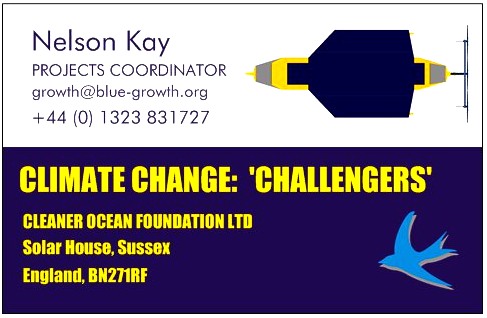
CONTACTS Briggette Dusart Sustainable
Ocean Transport Project Bluebird
Marine Systems Ltd Cleaner
Ocean Foundation & Solar
Studios, BN271RF United
Kingdom
growth@blue-growth.org
LINKS
& REFERENCES
http://www.speedysbvi.com/
http://www.qe4ferry.com/
http://www.ferriesdelcaribe.com/
http://www.caicosproperties.tc/TCIFerryService.html
http://www.alburysferry.com/
https://www.baleariacaribbean.com/
https://www.travellerspoint.com/guide/Caribbean_ferries/
http://caribya.com/caribbean/ferries/
http://www.blue-growth.org
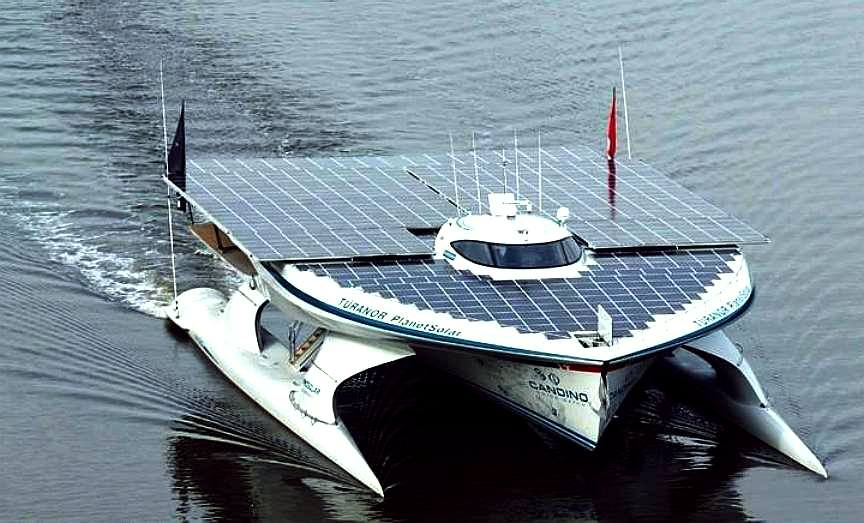
GUINNESS
BOOK OF RECORDS -
MS
Turanor PlanetSolar (Switzerland) navigated the world in
a westward direction from Monaco in 1 year 7 months and 7 days
from 27 September 2010 to 4 May 2012. We wonder why nobody has
attempted to improve on this design, to challenge the record in the intervening seven
years.
Imagine this
vessel scaled up with twice the thrust.
|
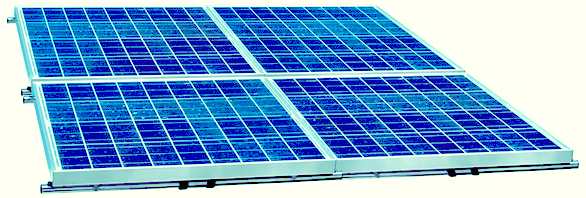
|

|

|

|

|
|
Large 334 m2 solar arrays that track the sun
autonomously.
|
Weight
saving 5083 alloy trimaran hull for a corrosion
free life.
|
Propellers,
shafts and transmission designed for improved
efficiency.
|
High
efficiency
dc brushless motors for propulsion and reliable
operation.
|
Computer
automated
hydraulic
actuators.
|
|
|
|
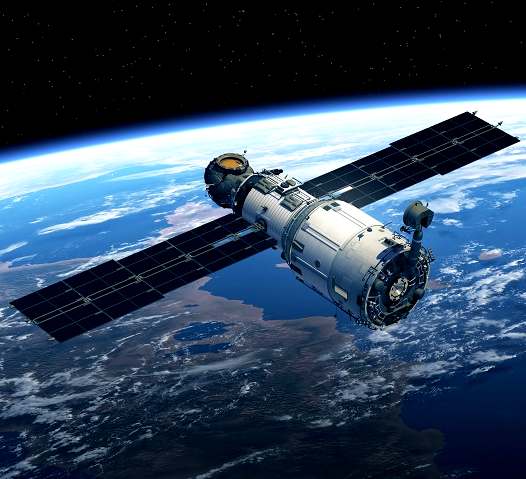
|
|

|
|
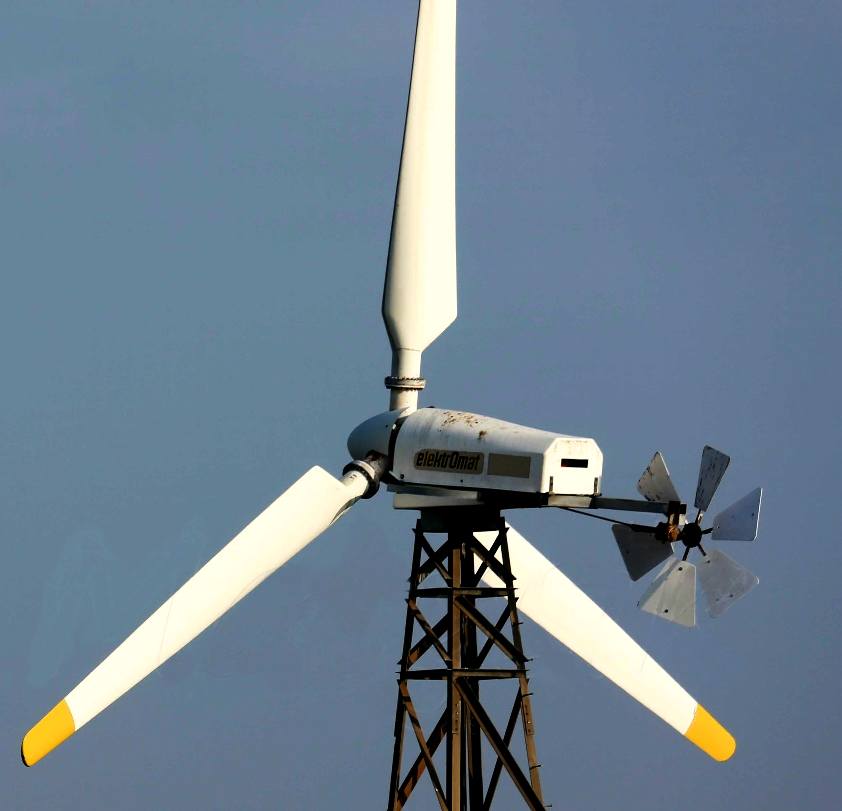
|
|
World navigation event
to demonstrate superior satellite route planning.
|
|
SDG 13 - Designed to
aspire to the UN sustainable
development goals.
|
|
20kW
wind turbine
boom
mounted
to track wind autonomously.
|
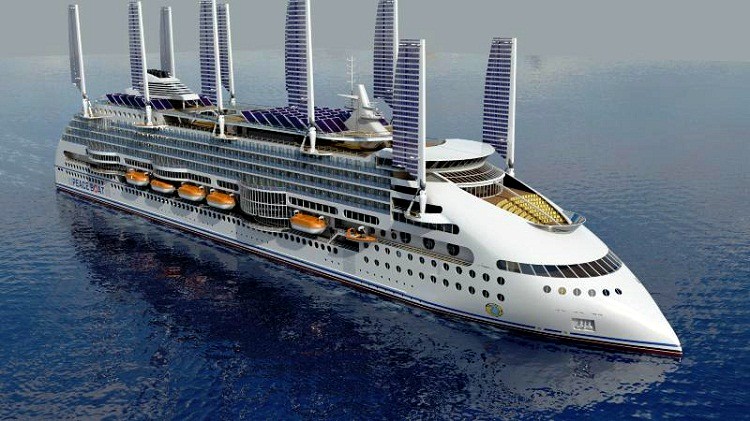
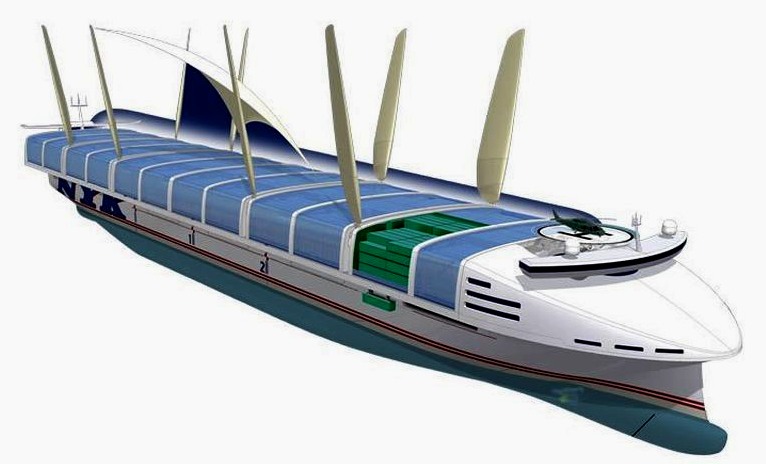
TRANSFERABLE
TECHNOLOGY - The design of the Climate Change Challenger
might be adapted to Cargo, Container, Cruise and Ferry
designs, without needing to radically alter port facilities.
The designs above are not representative of adaptations of the
concept, but serve to illustrate the thinking of other design
houses.
Please use our A-Z
INDEX to navigate this site
AEGEAN
- ADRIATIC
SEA - ARCTIC
OCEAN - ATLANTIC
OCEAN - BALTIC
SEA - BAY
OF BENGAL - BERING
SEA - CARIBBEAN
SEA - CORAL
SEA
EAST
CHINA SEA - ENGLISH
CHANNEL - GULF
OF GUINEA - GULF
OF MEXICO - INDIAN
OCEAN - IONIAN
-
IRISH SEA - MEDITERRANEAN
SEA
NORTH
SEA - PACIFIC
OCEAN - PERSIAN
GULF - SEA
OF JAPAN - SOUTH
CHINA SEA - SOUTHERN
OCEAN - TYRRHENIAN
|




